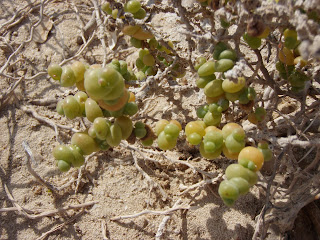Yesterday was our first day of field sampling. We went to the boat launch where our boat was put into the water by a tractor.
Since it was our first day, there was a bit of roaming around to find the right locations to sample. All the while, we were surrounded by the Abu Dhabi urban landscape.
We finally ended up on Jubail Island, and honestly thought that we were pulling up to some remote resort and someone was going to bring me out a mojito.
After reality quickly set in, I got my gear together, joined the crew, and we started to measure the mangroves. Before I say anything more about the day, I have to say how awesome mangrove trees are. I've never worked with them before and only had a peripheral sense of what they're like. And now that I'm actually working in them, I think that they are amazing! First off, they secrete salt from the marine water they're regularly inundated with through their leaves (one of the many awesome ways that salt marsh species manage to live in a toxic environment for plants).
For this particular species, they also can tolerate the inundation due to the pneumatophores that are roots that grow above the ground and they're covered in little openings called lenticels. Lenticels allow oxygen into the plant, since flooded soils are largely devoid of oxygen. Pneumatophores are everywhere!!!
We laid out a 100m transect and started to systematically measure the trees, collect soil cores, and do all of the other fancy measurements.
Once we were done measuring the mangroves, we moved inland to where the salt marshes are. To my surprise, the marsh looked like what I would encounter in San Francisco Bay, only the dominant species is Arthrocnemum macrostachyum instead of Salicornia pacifica.
So far, we've found three salt marsh species and I must admit that I have a new favorite plant now, Halopeplis perfoliata - String of Pearls
I came across a species that I have never seen before but I was able to figure out that it's a holoparasitic plant - Cistanche tubulosa!
Today we went to a site that was right next to Abu Dhabi and the mangroves were way denser and taller. I had fun crawling through the trees. The site actually had about 15cm of a peat layer, which we didn't see at the last site. I was walking in between plot locations by myself when I heard the call to prayers happen. It was an experience that I'm having a hard time putting into words, but I can say that it's left a mark on me, in a good way. I had two volunteers working with me that were from the local women's college. They had never done field work before and one of then said to me 'I feel like I'm on the National Geographic channel' with the biggest smile on her face. Wahoo! I'm making wetland converts across the world!
Enough writing for today. Below are photos from the outskirts of the mangrove and salt marsh (which we called the Flamingo sites since flamingos were nearby)


















This is so cool! Amazing plants and amazing environment. Some equipment looks familiar - those Li-Cor boxes feel must feel heavy by the end of the day of measurements, but they are important!
ReplyDelete